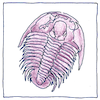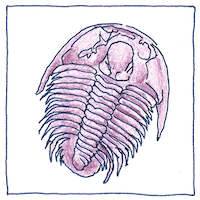Conrad Gessner
paleontology

|
Fossils
Collect, describe, and try to understand “stony concretions” out of the ground as Swiss naturalist Conrad Gessner in his book De rerum fossilium, lapidum et gemmarum, the first illustrated book on fossils, compared glossopetræ with shark teeth likely without thinking that one derived from the other.
Tongue stones
They fell from the sky during moonless nights, Pliny the Elder said. Maybe they grew naturally in the rock. Tongue stones dragon tongues serpent tongues Maltese tongues tongues of Saint Paul were said to detoxify a poisoned drink or counteract a snakebite.
Remnants and traces
If fossils tell us nothing is immutable, they also tell us a trace might remain. Cleaning out my garage, I can hardly remember where some of these things came from. Like the classic fable about the man who was granted eternal life but forgot to ask for eternal youth the past has withered into remnants and traces.



Gessner claimed that his woodcuts were the first illustrations of fossils to appear in print. This was not true; however, his catalog was the first that was not arranged alphabetically; his fossils were arranged by shapes.
See also in The book of science:
Readings in wikipedia: